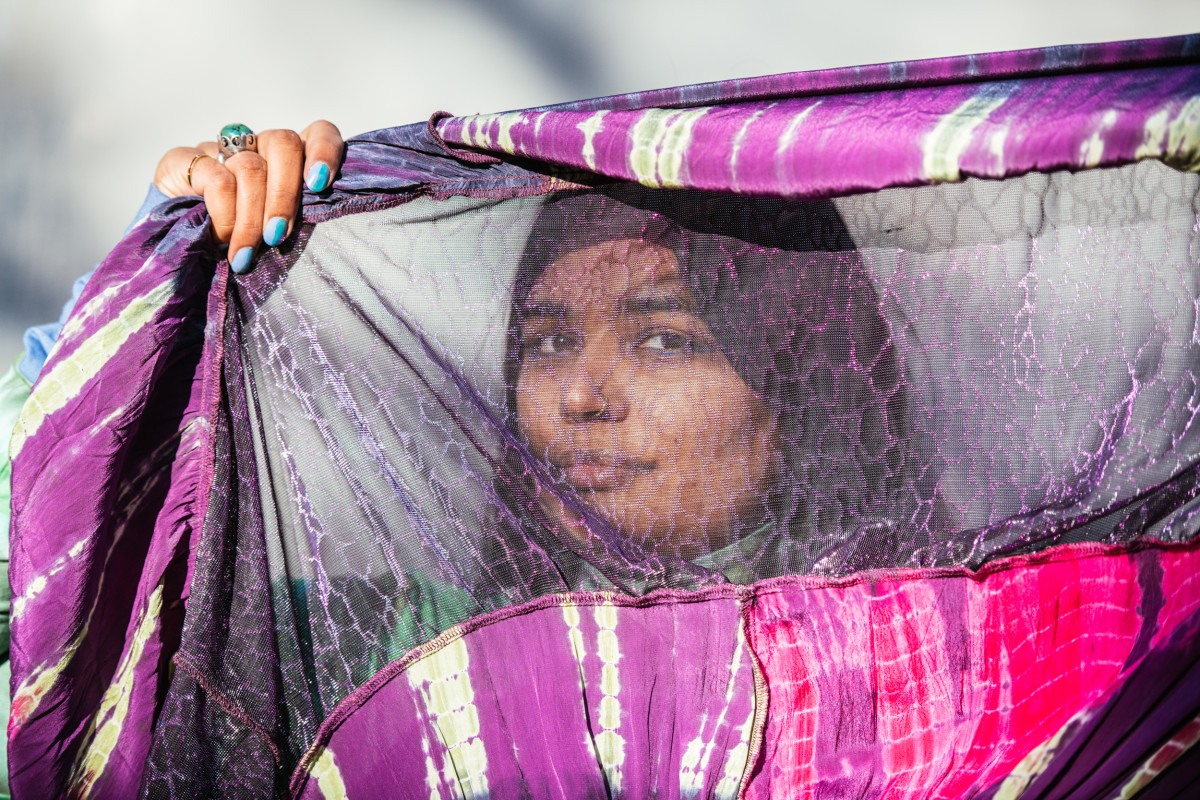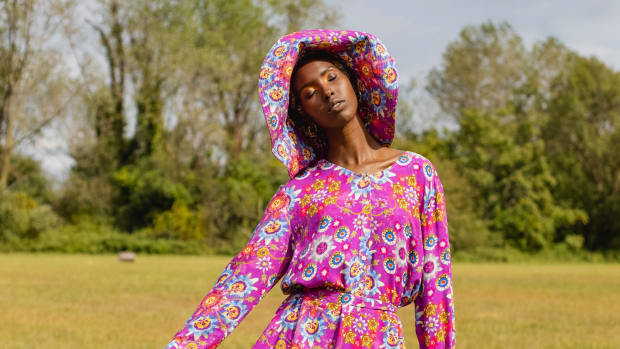At the height of the pandemic last March, Sheena Sood didn't join the flocks of those New York City residents fleeing the five boroughs. The founder and designer of fashion label
Abacaxi stayed put in her Brooklyn apartment and made masks — thousands of them. Some were beaded, others tie-dyed, all hand-worked, escapist and of course, evocative of far less dystopian time.
"I was trying to think about what I could contribute, and for me, masks were one thing I could do," she remembers. "There wasn't much else you could focus on, so I just started making them and when I put them on my Instagram Stories, everybody needed them."
The masks didn't just give her a purpose during a terrifying, dizzying time. They also brought her textile-forward sustainable brand — which, at that point, had been in operation for more than seven years — to an entirely new consumer base when most business was sputtering to a halt.
This March, Sood had other plans. As the first twinges of pre-crisis normalcy began sweeping into Brooklyn, Sood boarded a flight to the Mexican coastal state of Oaxaca to commence an artists' residency. For nearly five weeks, she studied the art and practice of traditional plant dying, all under the tutelage of a master dyer.
As a richly biodiverse region, Oaxaca has long been one of Mexico's leading producers of handcrafts, the processes for which the region's Indigenous groups have perfected over thousands of years. Sood arrived hoping to learn more about one of those processes, specifically: cochineal dyeing, derived from parasitic insects found on the pads of prickly pear cacti. The small, beetle-like bugs produce carminic acid, which, when extracted, yield a vibrant red ink.
Sood put her new expertise to work right away when she returned to Brooklyn and, not three months after her residency came to an end, cochineal-dyed pieces — including one particularly slinky, two-tone lavender slip dress — became available to shop on Abacaxi's website. Such is the Abacaxi way.
"Every designer has their own specialty, and fabric design is mine," says Sood. "I know that a lot of larger designers buy the original artwork from an artist or from a textile designer. The advantage for me is that, well, not only do I not have to do that, but creating those custom fabrics and prints is just part of my process."
Sood's fashion prowess kicked in early, and like many millennials, came heavily inspired by the Delia's catalogs that would arrive in her mailbox each month. But in retrospect, she recalls drawing more influence from her family's visits to India, during which she often found herself at local markets with her mom and aunt, surrounded by a kaleidoscope of fabric and color.
"I was fascinated by the fact that you could just get your fabric, take it to the embroiderer, take it to the beading guy, take it to the tailor and literally design your own clothes," she says. "That, obviously, was a huge part of why I later became a designer."
By the time Sood headed to college, textile design had crossed over from a personal, familial interest to a professional one. Sood studied visual arts at both Brown University and Central Saint Martins, where she incorporated textile techniques like tie-dyeing, beading and embroidery into her painting and photography. Upon graduation, she cut her teeth as an assistant designer at Tracy Reese, developing artwork and designs for new prints and embellishments. In 2012, she left her role and headed to India, where her parents were living, to take some time off.
Related Articles:
In Fashion, Regenerative Farming Isn't an Impossible Solution
3 Up-and-Coming Designers Who Could Shape the Future of Sustainability
By Reinvesting in Artisans, This Brand Is Changing the Way Apparel Treats Its Skilled Workers
"When I came back, I was looking for another job, but I also wanted to do something with textiles I had collected and started thinking about what I wanted to make with them," says Sood. "At the same time, I met someone who had a boutique in Park Slope, and she was carrying other ethically- or locally-made pieces. She encouraged me to make some pieces for her store."
Recommended Articles
In 2013, the very first Abacaxi capsule was born — though really, it wasn't official until Sood was able to assign it the perfect name. Enter abacaxi, a large, sweet pineapple grown largely in Brazil.
"I was thinking about my travels in Brazil that happened years before, and I knew that I wanted the brand to be very tropical-inspired and joyous and happy," she explains. "Pineapples are symbols of happiness and good luck, so the word 'abacaxi' came to me. The brand started building from there."
For nearly five years, Sood worked on Abacaxi as a side project while freelancing in textile design for brands like Cole Haan, Rachel Roy and Anthropologie. By 2018, Sood had accrued enough savings to run with Abacaxi full-time, and she relaunched it into what it is today: a celebration of traditional textiles created in small batches and in collaboration with artisans and weavers throughout India and Peru.
Come February of 2020, Abacaxi was riding high, showing at Paris Fashion Week. But with COVID-19 taking hold, Sood hightailed it back to Brooklyn, where she turned to mask-making.
"It started with me making and selling them myself, but I had to figure out very quickly, within a couple of weeks, how I could scale up," she says. "It's not like I had a whole setup here, as a really small brand. Everything was completely shut down, but all the sewers I've worked with, many of whom were in Brooklyn, were also looking for work. I had four or five sewers making masks from their homes for several months."
Abacaxi's masks took off early, earning the brand a flutter of industry attention from publications like InStyle, New York and Essence. In September, Teen Vogue named Sood to its 2020 Generation Next class, a competitive mentorship program for emerging designers.
"The mask customer is a much wider customer than the clothing customer, so it led to so much more traffic and online sales," she says. "You never know what the universe has in store for you, and it gave me some belief that this is what I'm supposed to do."
But don't go about calling Abacaxi an overnight success. Sood has been building the brand since 2013, after all, and it's taken just as long to forge a supply chain with which she's comfortable serving as the backbone of her brand. Today, Abacaxi's partners include a production workshop in New Delhi and weavers in Peru. Plus, she uses mostly natural (or even upcycled) fibers like cotton khaki, linen, silk and alpaca. Speaking of cotton: Sood recently inked a partnership with Oshadi Collective, an industry-beloved regenerative agricultural group that restores damaged cotton farms in South India.
"We call it regenerative farming, but it's really ancient Indian farming," says Sood. "It's a return to the way that cotton was grown when it was still sustainable, before agriculture became colonized by methods of massive growing. The plant gives you more when you let it do its own thing."
The regeneration that Oshadi Collective is promoting is, in a way, a further extension of her identity as a South Asian-American woman, which remains at the heart of everything Sood does with her label.
"My whole goal, and what drove me to want to start Abacaxi, was to bring these exquisite and sometimes rare textile techniques back into the everyday," she says. "I'm very much inspired by my heritage, both the richness of the textiles, but also the history behind all of them. I couldn't help but be vocal about it because I think the work itself is more vocal than I am."
Never miss the latest fashion industry news. Sign up for the Fashionista daily newsletter.






